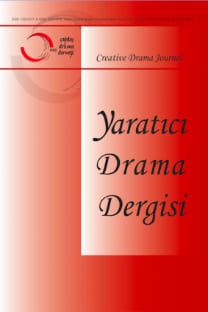Doğaçlama Dans Yaklaşımlarından Birisi: Dokuz Nokta Tekniği
Bir dansçı için koreografi kurgulayarak dans etmek ve doğaçlama dans etmek farklı şeylerdir. Koreografi kurgulayıp dans etmek için dansçı, tekrarlamalar yoluyla bir otomatizm geliştirir. Doğaçlama ise tekrar edilemezdir, bu yüzden doğaçlama dansçısı sürekli bir gerçekleştirme, hayata getirme durumundadır. Dans da doğaçlama bir dolaşımdır (diyalektik bir döngüsel geri bildirimdir). Bu dolaşım, düşünme ve düşünmeme, bilme ve bilmeme ile birlikte dansın dinamik gerilimini yaratır. Ya da diyalektiği dışarıda bıraktığımızda, doğaçlama esnasında dansçı bilip bilmeme arasında hareket eder. Sonuçta bu durumların birisine ya da diğerine geçici dengesizleşmeden ötürü hiçbir zaman tam olarak ulaşılamaz. Doğaçlama dans edebilmede dansçıya spontane bir şekilde dans edebilmek için yardım eden birçok ilke ve yön vardır. Dokuz nokta tekniği, vücudun hareket ederken yönelmesine yardım eden basit bir mekân içi modeldir. Amanda Miller bu doğaçlama pratiğini kendi atölyelerinde, performansta hareketin araştırılması ve dansçılara mekân içerisinde net ve belirli bir hareket kurmak ve doğaçlama alıştırması yaptırmak için kullanır. Böylece dans, seyirciler için rahatlıkla okunabilir hale gelir. Bir performans alıştırması olarak dokuz nokta tekniği spontane bir şekilde dansın oluşturulması için yapı/işaret verir.
Anahtar Kelimeler:
Dokuz nokta tekniği, Doğaçlama dans
One Concept of Dance Improvisation: The Nine Point Technique
For a dancer dancing a set choreography and dancing improvisation is different. For dancing a set choreography the dancer has developed an automatism through repetition. Improvisation is not repeatable, therefore the improvising dancer is in a permanent state of actualisation. Improvising means creating dance in the moment and for that creative process “to think“ means to engage (spatial and rhythmic) imagination. In dance improvisation it is a circulation (a dialectical feedback loop) of both thinking and not-thinking, knowing and not-knowing, which creates the dynamic tension of the dance. Or better – leaving a dialectic behind – during improvising the dancer moves in the intervall of knowing and not-knowing. The total states of either the one or the other are never fully reached, because of permanent destabilization. For being able to do improvisational dance there are many concepts and orientations, which help the dancer to compose the dance spontaniously. The NinePoint-Orientation is simply a model in space which helps the body to orientate while moving. Amanda Miller uses this improvisation-practice in her work, for the research of movement, in performance and also as a training for the dancers to write improvised or set movement clear into the space, so that the dance is clearly readable for the audience. As a performance practice, the nine-point-technique gives a structure/score for creating the dance spontaniously
Keywords:
The nine-point-technique, Dance improvisation,
- ISSN: 1305-8177
- Başlangıç: 2006
- Yayıncı: Gençlik Kulübu ve Çağdaş Drama Derneği
Sayıdaki Diğer Makaleler
Doğaçlama Dans Yaklaşımlarından Birisi: Dokuz Nokta Tekniği
Which Drama? Creative or Theorical
Yaratıcı Drama Eğitiminin Ergenlerin Sosyal Becerilerine Etkisi
Seden ABACI, Kezban TEPELİ, Filiz ERBAY
Keziban ÖKTEN, Özlem Öznur GÖKBULUT
Türkçe Ders Kitaplarında Drama Etkinlikleri
Is Creative Drama a Way to Excellence in ELT Classrooms?
Halk Danslarında Profesyonelleşme; Öncü bir Örnek Olarak Moiseyev Ekolü
Suna ARSLAN, Emir Tufan ÇAYKUŞ
Psikolojik Danışman Adaylarıyla Yaratıcı Drama Çalışmasının Mizah Tarzlarına Etkisi
